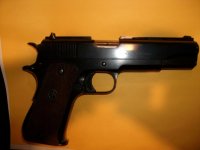palmetto99
Member
Anyone know much about them? Saw one in 9mm at a local gen shop.
 .
.They run hot & cold as far as quality. That can be said for nearly all the Spanish makers.
But of the handgun makers, the big 3 of Star, Astra and Llama,,Llama has least best reputation and resale value of the 3.
I've owned all kinds of them from all era's. Mostly Astra and Star. The Astra products are probably the best made speaking of the 300,400,600 series. Then the Star and lastly the Llama.
Llama models are a confusing grouping of names and then Roman Numeral designations. When Stoegers took over importation of them into the US, they added some extra model designations along with it.
I've owned quite a number of the small miniature 1911 Especial Llama in 22, 32 and 380. Those are very popular and sell well especially the 22's. Even those are all over the place in quality.
You can get a good one and have no problems with it, or you can have a real problem child on your hands. The latter unfortunately not that uncommon w/a Llama product.
The 1911 style pistols of both the Llama and Star brand are different from the Colt 1911 design in many ways and it's just by chance that a part here and there will interchange.
The 1911 looks and the price usually draw in the buyer. But the result is not always a lasting relationship.
A jam-o-matic is a frustrating thing to own. Magazines are hard to find and expensive to buy for replacement and that's usually the first place you start to look for problems.
Parts are difficult to get now & expensive when you find them most times. All three are out of business, at least in their original form.
For the very late mfg pistols it can be easier to get parts especially the Star models which were a Military issue..
FWIW,,on most any Star or LLama 1911 looking centerfire pistol,,DO NOT carry the pistol with a live round in the chamber and the hammer DOWN. The design is not like the Colt where the firing pin is spring loaded and rebounds after striking the primer.
In most all Spanish designs, the firing pin is longer than the breech block and a hammer resting down on the firing pin is placing the the tip of the pin out the face of the breech.
If a cartridge is in the chamber, the tip of pin is resting under pressure upon the cartridge primer.
A real hazzard if the gun is dropped or hammer is hit with it being down on a live cartridge. There's no rebounding hammer or firing pin.
You either have to trust the thumb safety and carry it cocked and locked. Or carry with the chamber empty.
There is a half cock notch, but like the Colt, it isn't for carry, it's to catch the hammer in the event it slips off the full cock notch,,nothing more..
The thumb safety should visibly cam the hammer backwards and off of the sear when engaged. It should be a one handed operation. No extra pull back on the hammer should be needed to engage the thumb safety. If that extra pull on the hammer is needed, and/or you can't see the hammer cammed to the rear and off the sear,,the safety is not operating correctly..
The old 'soft Spanish steel' theory really comes into play here and many of these pistols suffer from the problem.
added:
"But with the slide off, you could see where someone had scratched the underside with a nail (?), probably to test for hardness. "
You may have been looking at the 'assembly number' used by most Spanish pistol makers.
They most all use(d) the simple Roman Numeral system as an assembly number. Simple to scratch or even stamp into the metal with nothing more than a straight blade punch to make all the figures. Even the most unread person can follow the figures and match them up to the same numeral that appeared on the tray that all the parts were matched to as they made their way thru production.
When the gun was finished,,the tray was sent thru production again and another gun got the same numeral assembly number applied to it as it went along.
The practice was used in other types of manufacturing also to keep track of matching parts.
Simple, easy to apply and everyone could understand it,,even if you didn't really know what it said.
The underside of the slide breech was a common place to mark the slide, Frames are commonly marked down in the recoil spring cut out.
You can find the Roman Numeral match up figures on the back of fancy carved grips also.
